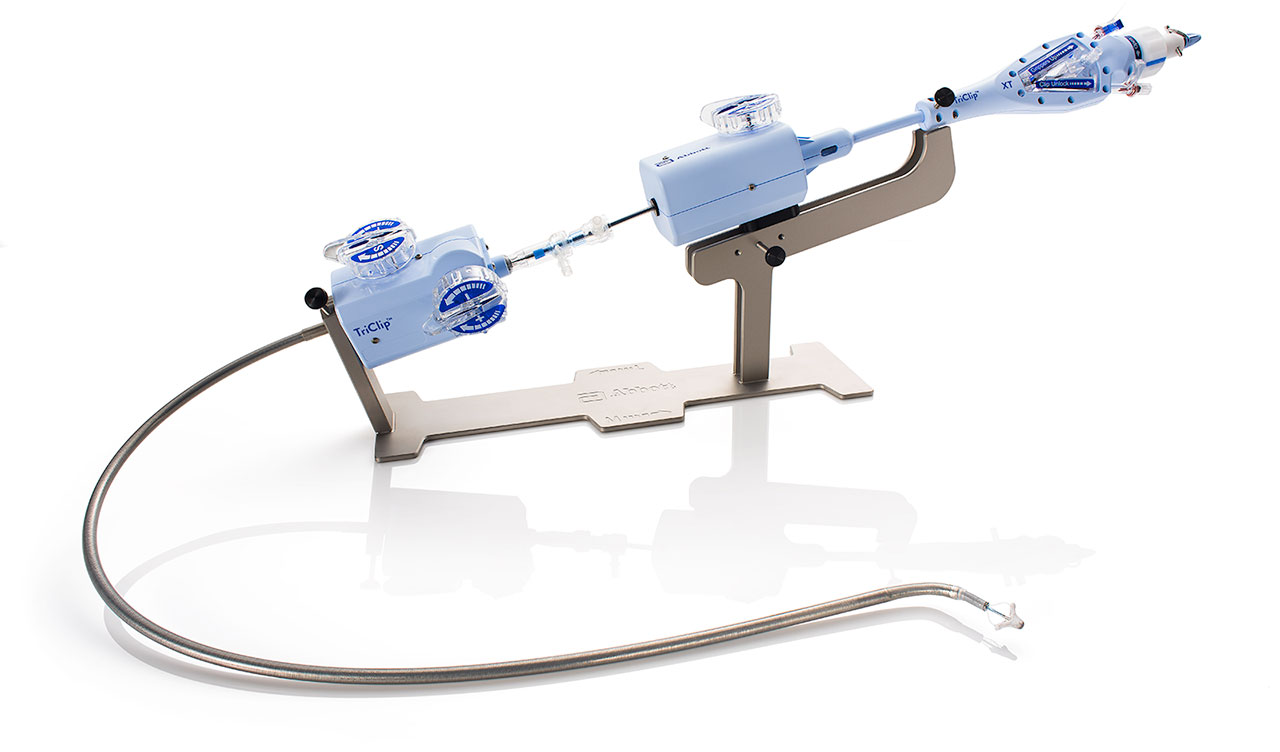The TriClip G4 System offers a minimally invasive treatment option for improving quality of life and functional status in patients with symptomatic severe tricuspid regurgitation, despite optimal medical therapy, who are at intermediate or greater risk for surgery and in whom transcatheter edge-to-edge valve repair is clinically appropriate.

- Catheter designed for stability and control when navigating and crossing the valve3-6
- Retaining forces are distributed across the frictional elements minimizing the risk of leaflet protrusion*7,8,13
- Low risk of intra- and post-procedural adverse events at 30 Days1,2
- Little to no risk of pacing or required adjunct therapies1,9
- Anatomically designed for the height you need for direct access to the valve3,10
- Multi-axis steering enables you to navigate across all lines of coaptation while maintaining perpendicularity to the valve plane*3,10
- Designed for deepest leaflet insertion to optimize leaflet coaptation and ensure leaflet retention during closure*11
Improvement of 15 points in the KCCQ-OS reported in more than 50% of patients at 1-year in randomized study, and an average of 21 points increase in the KCCQ-OS in the real world study1,12
*Test(s) performed by and data on file at Abbott.
Data from Triluminate Pivotal demonstrates that 89% of patients achieve TR moderate or less at 1-year1
- 98% Freedom from MAEs at 30 days
- 0% Non-elective surgery at 30 days
- 0.6% New pacemaker at 30 days
- 0% Thrombosis at 30 days
TriClip TEER demonstrated to be superior to medical therapy alone in improving Quality of Life (QoL) and reducing TR.
| Product Code | Description | Piece Count |
|---|---|---|
| TCG40100 | TriClip G4 System | 1 |
| TCDS0301-NT | TriClip G4 NT Delivery System | 1 |
| TCDS0301-NTW | TriClip G4 NTW Delivery System | 1 |
| TCDS0301-XT | TriClip G4 XT Delivery System | 1 |
| TCDS0301-XTW | TriClip G4 XTW Delivery System | 1 |
| TSGC0201 | TriClip G4 Steerable Guide Catheter | 1 |
| Product Code | Description | Piece Count |
|---|---|---|
| SZR07 | Stabilizer | 1 |
| LFT07 | Lift | 1 |
| PLT07 | Support Plate | 1 |

MAT-2401621 v1.0
TRICLIP™ CLIP G4 SYSTEM
INDICATIONS
The TriClip™ G4 System is indicated for improving quality of life and functional status in patients with symptomatic severe tricuspid regurgitation despite optimal medical therapy, who are at intermediate or greater risk for surgery and in whom transcatheter edge-to-edge valve repair is clinically appropriate and is expected to reduce tricuspid regurgitation severity to moderate or less, as determined by a multidisciplinary heart team.
CONTRAINDICATIONS
The TriClip G4 System is contraindicated in patients with the following conditions: Intolerance, including allergy or untreatable hypersensitivity, to procedural anticoagulation; Untreatable hypersensitivity to Implant components (nickel-titanium alloy, cobalt-chromium alloy); Active endocarditis or other active infection of the tricuspid valve.
POTENTIAL ADVERSE EVENTS
The following events have been identified as possible complications of the TriClip G4 Procedure. Allergic reactions or hypersensitivity to latex, contrast agent, anaesthesia, device materials and drug reactions to anticoagulation, or antiplatelet drugs; Additional treatment/surgery from device-related complications; Bleeding; Blood disorders (including coagulopathy, hemolysis, and heparin induced thrombocytopenia (HIT)); Cardiac arrhythmias (including conduction disorders, atrial arrhythmias, ventricular arrhythmias); Cardiac ischemic conditions (including myocardial infarction, myocardial ischemia, unstable angina, and stable angina); Cardiac perforation; Cardiac tamponade; Chest pain; Death; Dyspnea; Edema; Embolization (device or components of the device); Endocarditis; Fever or hyperthermia; Fluoroscopy and transesophageal echocardiogram (TEE) related complications: Skin injury or tissue changes due to exposure to ionizing radiation, Esophageal irritation, Esophageal perforation, Gastrointestinal bleeding; Hypotension/hypertension; Infection including: Septicemia; Nausea or vomiting; Pain; Pericardial effusion; Stroke/cerebrovascular accident (CVA) and transient ischemic attack (TIA); System organ failure: Cardio-respiratory arrest, Worsening heart failure, Pulmonary congestion, Respiratory dysfunction or failure or atelectasis, Renal insufficiency or failure, Shock (including cardiogenic and anaphylactic); Thrombosis; Tricuspid valve complications, which may complicate or prevent later surgical repair, including: Chordal entanglement/rupture, Single leaflet device attachment (SLDA), Dislodgement of previously implanted devices, Tissue damage, Tricuspid valve stenosis, Worsening, persistent or residual regurgitation; Vascular access complications which may require additional intervention, including: Wound dehiscence, Bleeding of the access site, Arteriovenous fistula pseudoaneurysm, aneurysm, dissection, perforation (rupture), vascular occlusion, Embolism (air, thrombus), Peripheral nerve injury; Venous thrombosis (including deep vein thrombosis) and thromboembolism (including pulmonary embolism).
MAT-2402104 v1.0
Stay Connected